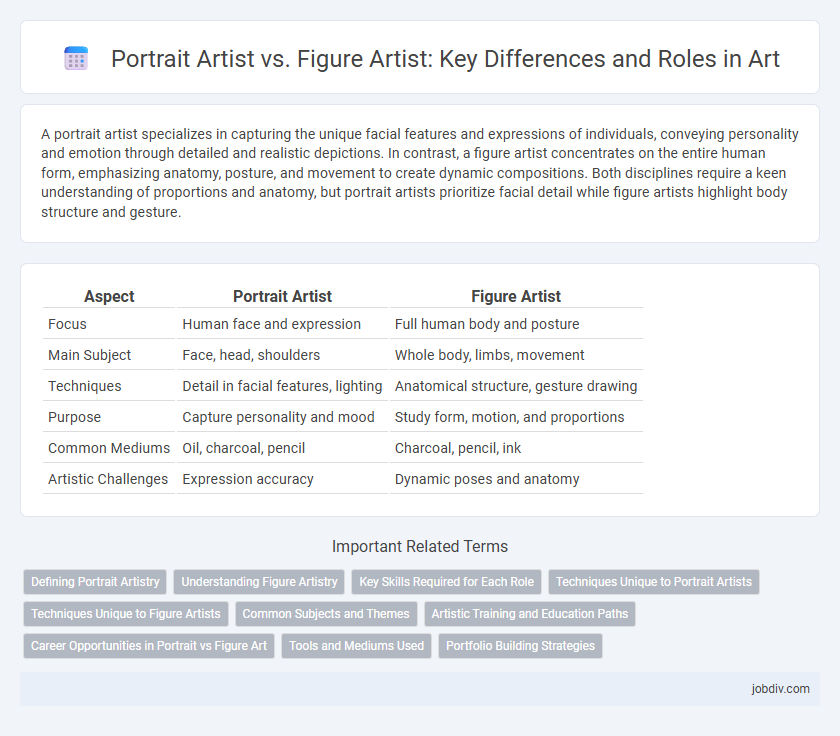A portrait artist specializes in capturing the unique facial features and expressions of individuals, conveying personality and emotion through detailed and realistic depictions. In contrast, a figure artist concentrates on the entire human form, emphasizing anatomy, posture, and movement to create dynamic compositions. Both disciplines require a keen understanding of proportions and anatomy, but portrait artists prioritize facial detail while figure artists highlight body structure and gesture.
Table of Comparison
| Aspect | Portrait Artist | Figure Artist |
|---|---|---|
| Focus | Human face and expression | Full human body and posture |
| Main Subject | Face, head, shoulders | Whole body, limbs, movement |
| Techniques | Detail in facial features, lighting | Anatomical structure, gesture drawing |
| Purpose | Capture personality and mood | Study form, motion, and proportions |
| Common Mediums | Oil, charcoal, pencil | Charcoal, pencil, ink |
| Artistic Challenges | Expression accuracy | Dynamic poses and anatomy |
Defining Portrait Artistry
Portrait artistry centers on capturing the unique facial features, expressions, and personality of an individual through detailed and emotionally evocative representation. Unlike figure artists who emphasize the entire human form and its movement, portrait artists specifically focus on the head and shoulders, highlighting identity and character. Mastery in portrait art involves precise anatomical knowledge, advanced shading techniques, and an acute sensitivity to subtle facial nuances.
Understanding Figure Artistry
Portrait artists specialize in capturing the likeness and personality of an individual's face, emphasizing facial expressions and features. Figure artists focus on the entire human form, studying anatomy, posture, and movement to depict the body accurately and expressively. Understanding figure artistry requires mastering proportions, muscle structure, and gesture to convey realism and emotion beyond facial details.
Key Skills Required for Each Role
Portrait artists require exceptional skills in capturing facial expressions, skin tones, and subtle nuances that convey personality and emotion. Figure artists excel in understanding human anatomy, body posture, and movement to depict the full form with accurate proportions and dynamic gestures. Both roles demand mastery of observation, shading techniques, and the ability to translate three-dimensional subjects onto two-dimensional surfaces.
Techniques Unique to Portrait Artists
Portrait artists specialize in capturing the intricate details of facial features, emphasizing expressions, skin tones, and the play of light and shadow to convey personality and emotion. Techniques such as precise brushwork for rendering eyes, subtle blending to achieve realistic skin textures, and careful study of anatomy ensure lifelike representation. Unlike figure artists who focus on full-body poses and movement, portrait artists prioritize the head and shoulders, mastering fine detail in facial proportions and individualized character.
Techniques Unique to Figure Artists
Figure artists specialize in capturing the human form through dynamic poses and anatomical accuracy, emphasizing gesture drawing and proportion studies. Techniques such as contour drawing, chiaroscuro for muscle definition, and foreshortening are essential to convey depth and movement in figure art. Unlike portrait artists who focus on facial features and expressions, figure artists master the body's overall posture and spatial relationships.
Common Subjects and Themes
Portrait artists primarily focus on capturing the facial expressions, emotions, and personality of individuals, often creating head-and-shoulder or bust representations. Figure artists emphasize the entire human body, exploring anatomy, posture, movement, and the interaction between forms in various poses and settings. Common themes for portrait artists include identity and character studies, while figure artists frequently explore themes of human form, gesture, and narrative through body language.
Artistic Training and Education Paths
Portrait artists often undergo specialized training in facial anatomy, expression, and skin tones, emphasizing capturing the subject's personality and likeness. Figure artists typically focus on broader studies of human anatomy, proportion, gesture, and movement, frequently practicing with live models to master body dynamics. Both disciplines benefit from foundational art education, but portrait art training leans more toward individual character detail, while figure art emphasizes holistic human form understanding.
Career Opportunities in Portrait vs Figure Art
Portrait artists have a strong demand in commercial and private sectors, including commissioned works, galleries, and corporate branding, providing consistent career opportunities. Figure artists often find opportunities in educational settings, fine art exhibitions, and performance art collaborations, emphasizing anatomy and movement skills. Both specializations can expand their careers through workshops, online courses, and digital art platforms, leveraging their unique expertise to attract diverse clientele.
Tools and Mediums Used
Portrait artists primarily use fine brushes, pencils, and charcoal to capture detailed facial expressions and subtle skin tones, often working with oil paints, pastels, or graphite. Figure artists favor broader tools like larger brushes, charcoal sticks, and conte crayons to emphasize the entire human form, frequently employing mediums such as acrylics, charcoal, and ink for dynamic gesture and anatomy studies. Both disciplines utilize sketchbooks and digital tablets, but the selection of tools heavily depends on the focus between facial detail and full-body representation.
Portfolio Building Strategies
Portrait artists should prioritize showcasing facial expressions, skin tones, and emotional depth, emphasizing close-up studies and diverse subjects within their portfolio. Figure artists benefit from including full-body poses, dynamic anatomy studies, and gesture drawings to demonstrate mastery of human form and movement. Both disciplines gain value by integrating high-resolution images and process shots to highlight technical skills and creative evolution.
Portrait Artist vs Figure Artist Infographic

 jobdiv.com
jobdiv.com